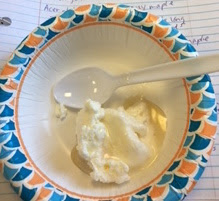Nothing strikes fear into the heart of a maple producer more than getting side tracked in the final moments of syrup production and cooking sugar onto the pan. This not only makes a mess that is hard to clean up but also can ruin the flavor of your entire batch. With the amount of preparation and manual labor that goes into sap collection and boiling, losing the batch at the final moments can be devastating. During my high school and college days working at Snell Family Farm during maple season, boiling was an evening ritual that felt like a reward for hard work earlier in the day. We would spend the evening stoking the wood fired evaporator and telling stories. As the thermometer in the finishing pan began to creep toward 219 degrees Fahrenheit (the boiling point of syrup), things got considerably more serious. The finished product had to be removed from the heat and filtered immediately or else BAD things could happen.

A close eye is kept on the thermometer in the final moments of syrup production.
I "finished" our first pint of syrup in class this past Monday and we were all able to enjoy warm maple syrup over ice cream. Saying syrup boils at 219 degrees Fahrenheit is a little oversimplified. In fact, maple syrup boils 7.1 degrees Fahrenheit above the boiling point of water. We generally think of the boiling point of water as 212 degrees Fahrenheit but this is a moving target. Elevation and barometric pressure can affect the boiling point of water and thus move the syrup target up or down.
Using they hydrometer to confirm our syrup is finished
Sap that has not yet reached the sugar concentration required to be called syrup can spoil quickly so it is important to confirm in a couple of ways that the syrup is truly finished. Another measurement that can confirm we have reached syrup is density. A nifty little tool known as a hydrometer uses principles of buoyancy to measure the density of a fluid. Maple sugar producers use a hydrometer calibrated for syrup to help confirm their product is finished. After hitting 219 degrees Fahrenheit in class, we tested our syrup using a hydrometer and confirmed we were done.
Filtering the final product
Finally, the hot syrup was poured through a filter consisting of a synthetic filter paper and multiple layers of cheese cloth. This removes all of the mineral, mostly potassium nitrate, that has concentrated in the syrup along with the sugar. Maple producers call this cloudy mineral sugar sand or niter. Finished syrup should be free of sugar sand and bottled hot to ensure there is no contamination in the container. We let our new jug of syrup cool for a few minutes before enjoying a long awaited taste of spring.
A sweet reward








